Russian version 
GT-48 Gamma-Ray Telescope
|
|
|
|
General description
|
|
Since 1973, under the leadership of Arnold Artashecovich Stepanyan, the staff of the
gamma-ray laboratory began development and construction of a new, more powerfull, model of the GT-48 gamma-ray Telescope that consists of 48 mirrors.
Observations of very high energy (VHE) cosmic gamma-ray sources were started in 1989 and they are still being carried out.
|
|
The GT-48 gamma-ray Telescope is located at a height of 600 meters above
sea level. The threshold energy for detection of gamma-rays is 1 TeV. The telescope consists of two identical alt-azimuth sections, north (N)
and south (S), which are 20 meters apart. GT-48 is used for observations of active galactic nuclei (AGNs): blazars, quasars. Observations of pulsars, radio, and X-ray sources are carried out as well.
|
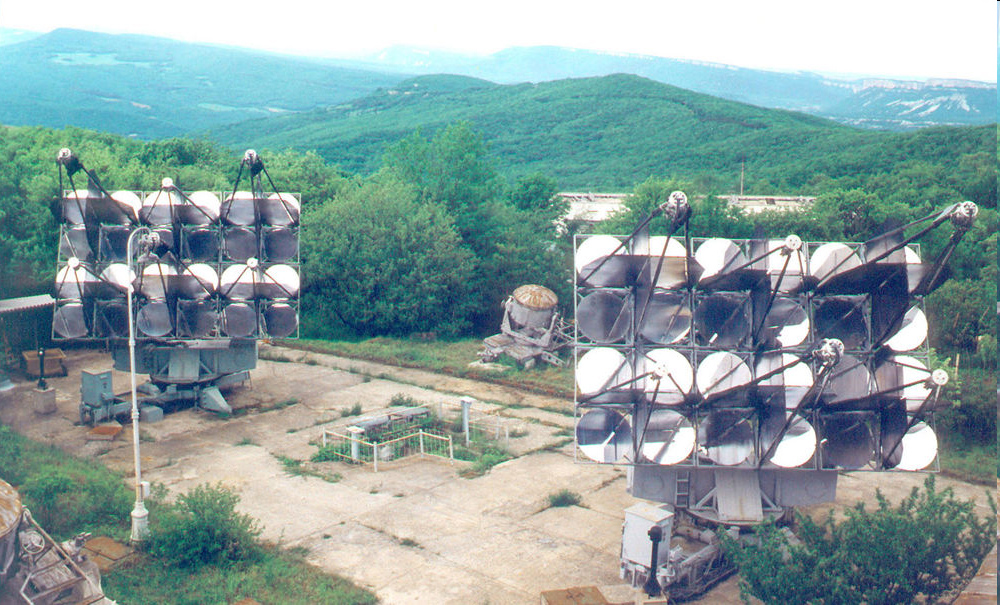 |
|
|
|
|
| Mounting: |
Alt-azimuth |
| Configuration: |
Two identical sections (North and Sourth) |
| Optical systems: |
Each section includes 24 spherical mirrors
D=1.2m, F=5m (16 mirrors), F=3.2m (8 mirrors) |
| Detector: |
Each section has four 37-channel cameras based on the photomultiplier tube (300–600nm) and two single-channel cameras based on the solar-blind photomultiplier tube
(200–300 nm) |
|
|
Go to content
|
|
Detailed description. Detectors.
|
|
The GT-48 gamma-ray Telescope is a couple of identical sections (mounts), which are located at a distance of 20 meters apart in the north-south direction.
|
|
Each mount (S and N) consists of the six telescopes (elements). The optics of each element consists of the four 1.2-meter spherical mirrors with the same focus.
|
|
Mirrors of the four elements have a focal length of 5m. There is a light detector (a camera) in the focal plane of each element. Each camera is comprised of 37 photomultiplier tubes (PMT-140) having a photocathode of 25mm in diameter. Images of the Cherenkov light in the visible region (300–600nm) are registered by these photomultiplier tubes. In front of each photomultiplier tube there is a conical fiber made of organic glass. The outer surfaces of the fiber entrance windows are located in the focal plane of a composite mirror and they have the hexagonal shape wich provides a tight packing of these windows, so there is no light loss when the light enters the detector. The optical contact bounding between the fiber entrance windows and the surfaces of the photomultiplier cathodes is provided by immersion process. The average diameter of the fiber entrance windows is 37 mm, that corresponds to the angular scale of 0.4 degrees per photomultiplier (per channel). The field of view of the detector is 2.6° and the image of the Cherenkov light is distributed to the 37 channels.
|
|
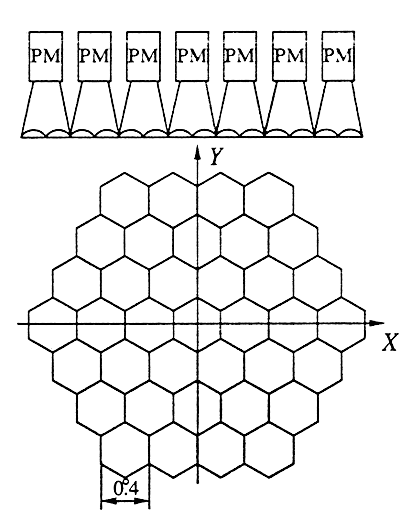

|
|
|
Layout of the light-detecting camera of the GT-48 Telescope and its design.
|
|
|
Signals from four cameras are co-added linearly. The Cherenkov light is only registered when amplitudes of simultaneous signals in any two of the 37 channels have exceeded the threshold. The time resolution for a coincidence circuit is 15 ns. The recording of the Cherenkov light and the control parameters of equipment is performed with the automated systems developed in the laboratory and with personal computers.
|
|
In addition, there are two more elements with a focal length of 3.2m that are intended for registration of the Cherenkov ultraviolet radiation in the range of 200–300nm. The ultraviolet detector is a solar-blind photomultiplier tube with a photocathode of 100mm in diameter. The peak of its spectral sensitivity is 2700Å, and long-wavelength sensitivity limit is ~ 3200Å.
|
|
An important part of the optical system are lens hoods (blends). Their purpose is to prevent the light pollution of the detector by a light coming from the mirrors of the adjacent elements. The absense of blends would result in an increase of the background light.
|
|
All six elements are mounted and adjusted on the support platform with a counterweight which is rotated around the horizontal axis. The total weight of the platform with an optical system is six tons.
|
|
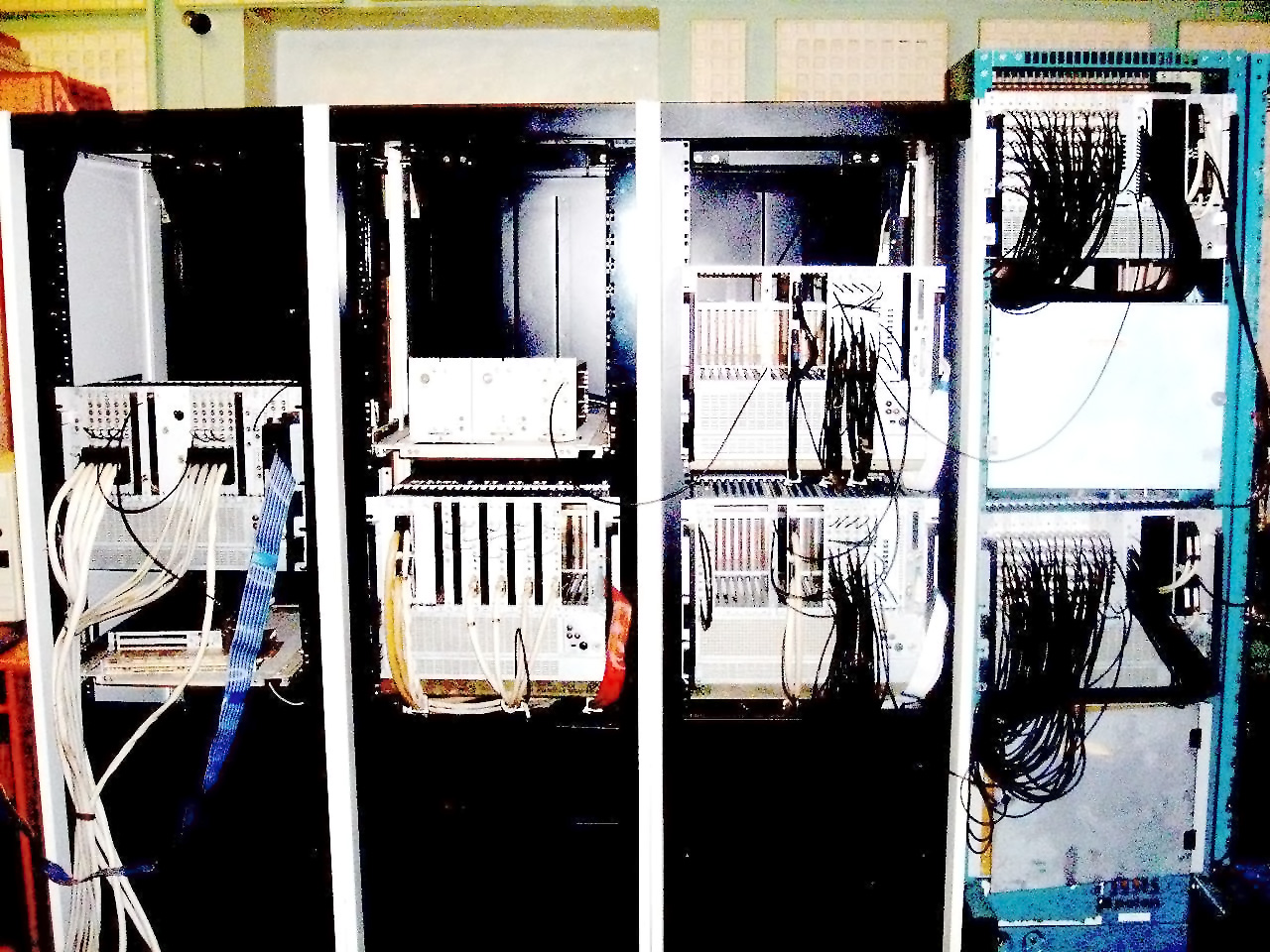
|
|
|
Measuring-recording system of the GT-48 Telescope.
|
|
The motion control of the GT-48 Telescope is implemented by using a special program developed by the laboratory staff for the control computer. The telescope drive tracking accuracy is ±0.05°. With this program the process of observations is completely automated. The dual detectors spaced at a distance of 20 meters or more, together with the coincidence circuit, completely exclude the registration of flares caused by local charged particles and muons.
|
Go to content
|
|
Observations
|
|
Now it is known that almost all the non-stationary processes in stars and galaxies are accompanied by generation of cosmic rays. However, it is not clear what processes are responsible for their generation. Gamma-ray observations permit us to study processes in which particles are accelerated to high and ultrahigh energies. The Earth's atmosphere is not transparent to gamma-rays in the entire energy range, so devices mounted on satellites are used to register gamma-rays in the range between 105 eV and 1010 eV. The registration of gamma-rays with energies Е>1011 eV is carried out with ground-based equipment. In the case of ground-based observations, the VHE gamma-rays are being interacted with atomic nuclei of the atmosphere and secondary electrons are formed. These electrons emit quanta of Cherenkov radiation in the optical range at a small angle (1°) to the direction of the primary gamma quantum motion, so it is possible to detect a region from which the gamma-quantum comes. The area illuminated by the Cherenkov light is quite large: tens of thousands of m2. Due to this, it is possible to detect a small flux (approximately 10-11 quanta per cm-2). The first gamma-ray telescopes have only registered the presence of the Cherenkov light, but a lot of observational time (up to several years) were required for confident detection of a source of gamma-rays. The main obstacle for detecting and further studying VHE gamma-ray sources is the presence of significant cosmic ray background, which particles trigger Cherenkov light in the Earth's atmosphere. It is difficult to distinguish them from flares caused by gamma-rays. However, the differences exist. Taking this fact into account, many research groups have constructed new, more complex gamma-ray telescopes. The main feature of gamma-ray telescopes of the second generation is a using of multi-channel cameras, with a possibility to obtain images of the Cherenkov light. Such a detection of the Cherenkov light makes it possible to cut off a large fraction of flares caused by a charged component of cosmic rays and it greatly improves the efficiency for detecting objects that emit VHE gamma-rays.
|
|
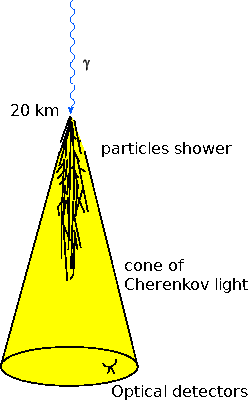 |
|
Scheme of the air shower
formed by high-energy gamma-rays. |
|
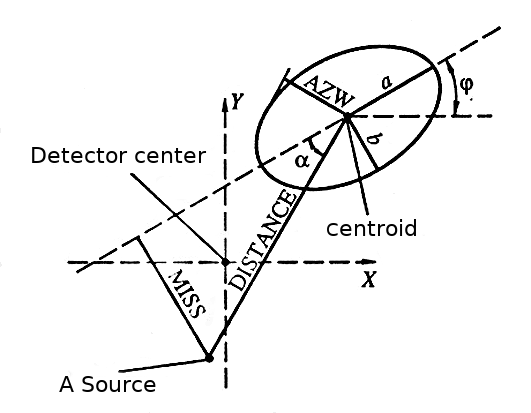 |
|
Schematic picture of some parameters of the Cherenkov light that is shown as an ellipse. The major semi-axis of the ellipse is marked as "a", while the minor semi-axis of the ellipse is marked as "b". DISTANCE is the angular distance between the flare center and the source, α is the angle between the major axis of the flare and direction from the flare center to the source, MISS is the shortest distance between the major axis of the flare and source, AZWIDTH is the azimuth width, and φ is the position angle of the burst, which characterizes direction of maximum elongation, i.e., its orientation. |
| |
|
The multi-channel detectors enable to detect regions on the celestial sphere, where the gamma-ray sources are located (Andreeva et al. 2000). To do so, the test source method is used (Akerlof et al. 1991; Neshpor et al. 1994; Fomin et al. 1994a, 1994b). In this method a three-dimensional image of distribution of the selected light flares in the field of view is built. The number of images of gamma showers depends sufficiently on the position of the suspected source and it has a maximum in the direction to the gamma-ray source.
|
|
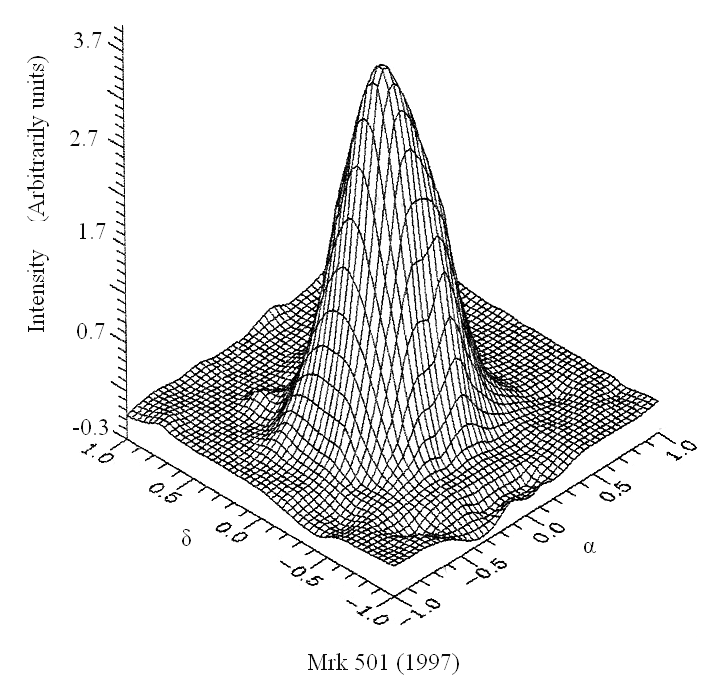
|
|
|
Three-dimensional image of distribution of arrival directions of gamma quanta for the Mrk 501 galaxy in 1997.
|
|
Go to content
|
|
Main Scientific Results
|
|
For observations in 1993, a new source of VHE gamma-rays has been detected with high confidence (7σ). This source is located near the X-ray source of Cyg X-3 (Neshpor et al. 1995). The new source has been called "Cyg γ-2" (Kalekin et al. 1996).
|
|
The observations of the Geminga pulsar in 1996-1997 showed that this object is a source of VHE gamma-rays. Gamma-ray flux from this source varies in time with a period of pulsar of 0.237 sec. and it is superimposed with another period of 59 seconds (Neshpor et al. 2001; Neshpor & Stepanyan 2001).
|
|
Fluxes of VHE gamma-rays have been found in both the 3C 66A and BL Lac nuclei (Neshpor et al. 1998, 2001).
|
|
Later, after ten years, these results have been confirmed by observations at other gamma-ray telescopes.
|
Go to content
|
|
|
|








